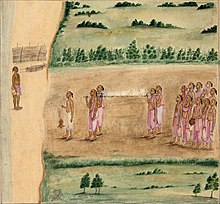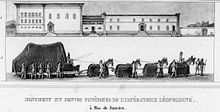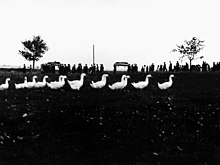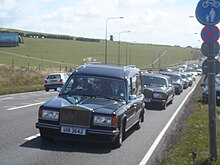Funeral procession
The examples and perspective in this article may not represent a worldwide view of the subject. (June 2010) |
You can help expand this article with text translated from the corresponding article in Dutch. (August 2012) Click [show] for important translation instructions.
|
A funeral procession is a
Hinduism

The Indian city of Banāras is knowns as the Great Cremation Ground because it contains Manikarnikā, the location where Hindu's bring the deceased for cremation. Manikarnikā is located in the center of the city along the Ganges River.
In more modern times and places outside of India, the domestic traditions of decorating the body,
Islam
In the Islam religion, the funeral procession is a virtuous act that typically involves a large amount of participation from other Muslims. Traditions that were begun by the Prophet are what urged Muslims to partake in the procession. Muslims believe that by following the funeral procession, praying over the body, and attending the burial one may receive quīrāts (rewards) to put them in good favor with
Christianity



In the Christian religion, the funeral procession was originally from the home of the deceased to the church because this was the only procession associated with burial. This is because the burial took place on the church property so there was no procession that occurred after the funeral service.
May the angels lead you into paradise
may the martyrs come to welcome you
and take you to the holy city,
the new and eternal Jerusalem.[1]
In the modern day, the funeral procession is no longer common or practiced in the same way. Now a hearse is used to transport the body to the gravesite. The procession consists of carrying the casket from the church to the hearse and then from the hearse to the gravesite once at the cemetery. The male family members and friends are typically the ones who carry the coffin.[1]
Buddhism/Shinto (Japan)

After a person has died the first thing to be done is to choose two people to be in charge of making all of the arrangements for the funeral events to come. The main relatives are in charge of encoffining the body and the female relatives make the death clothes that the deceased will wear. Once the body is prepared the wake occurs. This takes place the night before the procession and lasts through the night. Typically relatives and neighbors attend and food and alcoholic beverages are served.
During the Taishō era, funerals began to undergo many changes with one of the biggest ones being the elimination of the funeral procession. Funeral processions were extremely prominent during the Meiji era and part of the reason for ridding of them was to move away from the elaborateness of that time period and into more simplistic practices.[4] Another main reason for elimination of processions was the increase in public transportation and motorized vehicles, making the streets far too congested for large processions to occur.[4] As funeral practices moved away from the procession, kokubetsu-shiki (home farewell ceremonies) began to take their place. These ceremonies could be held at the family home, but sometimes were held at the funeral home or temple to replace the mourning that the funeral procession used to accomplish. These farewell ceremonies also served the purpose of offering condolence toward the grieving family in a social aspect.[4] With there no longer being a procession, the real and paper flowers that were carried began to be used to decorate the altar at the temple. The custom of placing a picture of the deceased on the altar also began during this period. Overall, the funeral procession changes were mainly attributed to "external societal conditions" rather than public opinions.[4]
Judaism
According to Jewish law, the deceased is to be buried as soon as possible so the time between death and burial is short. Burial cannot occur on the Sabbath or any Jewish holiday. The funeral service is brief and typically takes place at a funeral home, but sometimes is held at the
See also
- Corpse road
- Motorcade
- Jazz funeral
- Funeral train, using a railway train
References
- ^ OCLC 23133769.
- ^ a b c d Sumegi, Angela (2014). Understanding Death: An Introduction to Ideas of Self and the Afterlife in World Religions. Malden, MA: Blackwell Publishing Ltd. pp. 187–190.
- ^ Ocala Star-Banner. 24 May 1991. Retrieved 3 May 2012.
- ^ JSTOR 30233669.
- ^ OCLC 40619497.
- ISBN 978-0195148909.
- ^ ISBN 0691089531.
- ISBN 978-1598698626.
- ISBN 0304338516.
- ^ JSTOR 1596107.
- ^ S2CID 44358710.
- ^ )
